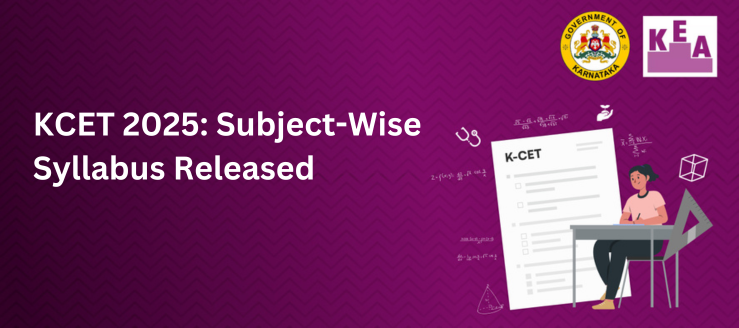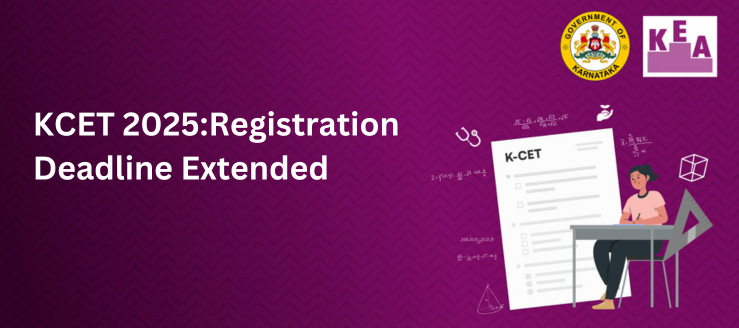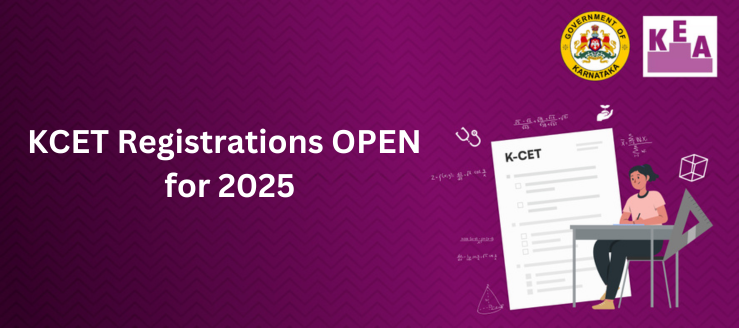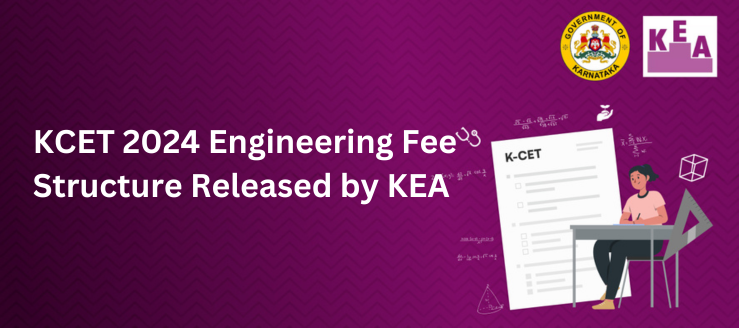
The Syllabus for KCET Exam has been released on the official website. The KCET exam for PCM Stream is based on three subjects Physics, Chemistry, and Mathematics. For PCB Stream, the exam is based on Physics, Chemistry, and Biology. The syllabus for both streams has been made available on the official website. The Syllabus is made available in PDF Format for Candidates’ easy accessibility.
The syllabus for the KCET Exam is based on the 11th and 12th class Syllabus. The Weightage for Class 12th is 80,% and for Class 11th, the Weightage is 20%.
Subject-wise Syllabus for 2025
| Subject | Syllabus |
| Mathematics | Click Here to Download |
| Physics | Click Here to Download |
| Chemistry | Click Here to Download |
Syllabus for Mathematics
Although each subject holds equal weightage in KCET 2025, Mathematics is a crucial subject that can significantly impact your overall score. A solid grasp of basic concepts will make it easier to Score more in the KCET Exam.
Here’s a detailed breakdown of the Mathematics syllabus for KCET 2025:
| Unit | Topics | Details |
| SETS | Sets and their Representations | Sets, empty sets, finite/infinite sets, subsets, universal sets, Venn diagrams, union, intersection, differences, complements, properties. |
| Relations & Functions | Ordered pairs, Cartesian products, Functions | Relations, functions, pictorial representations, domain, co-domain, range, real-valued functions, graphs of constant, polynomial, rational, modulus, and other functions, operations on functions. |
| Trigonometric Functions | Positive/Negative angles, Identities, Graphs, Expressions | Radian and degree conversions, trigonometric identities, signs, graphs, expressions for sin(x±y), cos(x±y), tan(x±y), etc., and higher-order trigonometric identities. |
| Algebra (Unit II) | Complex Numbers, Linear Inequalities, Permutations/Combinations, Binomial Theorem, Sequences & Series | Includes Argand plane, solutions on number lines, fundamental counting principles, Pascal’s triangle, arithmetic/geometric sequences, relations between AM and GM, etc. |
| Coordinate Geometry | Straight Lines, Conic Sections, 3D Geometry | Includes slopes, forms of line equations, conic sections (circle, parabola, ellipse, hyperbola), standard equations, and coordinate axes in 3D. |
| Calculus (Unit IV) | Limits, Derivatives, Applications of Integrals/Differentials | Includes the derivative as a rate of change, integrals as differentiation inverse, areas under curves, definite integrals, and solving equations using differentials. |
| Statistics | Measures of Dispersion | Mean deviation, variance, and standard deviation for grouped/ungrouped data. |
| Probability | Events and Axiomatic Probability | Events like “not,” “and,” “or,” exhaustive/mutually exclusive events, axioms, Bayes’ theorem, total probabilities. |
| Relations & Functions (Class XII) | Reflexive, Symmetric, Transitive, Inverse Trigonometric Functions | Definitions, graphs, principal branches, domain, range, and properties of functions and their inverses. |
| Matrices | Types, Operations, Applications | Includes types of matrices, addition, multiplication, scalar operations, properties, determinants (up to 3×3), adjoint, inverse, solving linear systems using matrices. |
| Vectors and 3D Geometry | Vectors, Scalars, Lines, Angles | Includes magnitude, direction, types of vectors, operations, scalar and vector products, equations of lines, coplanar/skew lines, shortest distances, angles. |
| Linear Programming | Graphical Methods | Terminology (constraints, objectives), solving two-variable problems graphically, feasible/infeasible solutions. |
Syllabus for Physics
Physics is a subject that relies on the application of concepts rather than theory. While preparing for Physics, you should Focus on understanding the Concept rather than just learning it.
Here is a detailed breakdown of KCET Physics 2025 Syllabus:
| Unit | Topics | Details |
| Units and Measurements | Need for Measurement | Units of measurement, systems of units, SI units, fundamental and derived units, and significant figures. |
| Dimensions | Dimensions of physical quantities, dimensional formulae, dimensional equations, dimensional analysis, and applications. | |
| Kinematics | Motion in a Straight Line | Frame of reference, speed, velocity, uniform and non-uniform motion, instantaneous speed and velocity, uniformly accelerated motion, velocity-time graph, position-time graph, graphical treatment of uniformly accelerated motion. |
| Mathematical Tools | Elementary concepts of differentiation and integration for describing motion. | |
| Scalars and Vectors | Position and displacement vectors, general vectors and notation, vector addition and subtraction, resolution into components, scalar and vector products. | |
| Motion in a Plane | Uniform velocity and uniform acceleration, projectile motion, and uniform circular motion. | |
| Laws of Motion | Basic Concepts | Force, inertia, Newton’s laws of motion, momentum, impulse, conservation of linear momentum. |
| Applications | Equilibrium of concurrent forces, common forces in mechanics, static and kinetic friction, rolling friction, and reducing friction. | |
| Dynamics of Circular Motion | Centripetal force, vehicle motion on level and banked roads. | |
| Work, Energy, and Power | Work and Energy | Work done by constant/variable force, kinetic energy, work-energy theorem, potential energy (spring), and conservative and non-conservative forces. |
| Conservation of Energy | Conservation of mechanical energy, motion in a vertical circle, elastic and inelastic collisions (1D and 2D). | |
| Motion of System of Particles and Rigid Body | Centre of Mass | Centre of mass of two-particle systems, rigid bodies, momentum conservation, the motion of the center of mass. |
| Rotational Motion | Torque, angular momentum, conservation of angular momentum, equilibrium, rotational dynamics, moment of inertia, radius of gyration. | |
| Gravitation | Gravitation Laws | Kepler’s laws, the universal law of gravitation, the gravitational constant. |
| Applications | Acceleration due to gravity (altitude and depth), potential energy, escape velocity, satellites, orbital velocity, and energy of orbiting satellites. | |
| Properties of Bulk Matter | Elasticity | Stress-strain relationship, Young’s modulus, bulk modulus, shear modulus, Poisson’s ratio, elastic energy, applications. |
| Fluid Mechanics | Pressure, Pascal’s law, equation of continuity, Bernoulli’s theorem, Stokes’ law, terminal velocity, streamline/turbulent flow. | |
| Surface Tension | Surface energy, angle of contact, capillary rise, drops, and bubbles. | |
| Thermal Properties | Heat, temperature, ideal gas equation, thermal expansion, specific heat capacity, latent heat, heat transfer mechanisms, black body radiation, Stefan-Boltzmann law, Newton’s law of cooling. | |
| Thermodynamics | First Law | Thermal equilibrium, internal energy, heat, work, thermodynamic processes (isothermal, adiabatic). |
| Second Law | Reversible/irreversible processes, Carnot engine. | |
| Behavior of Perfect Gas and Kinetic Theory | Kinetic Theory | Equation of state, assumptions, pressure, rms speed, degrees of freedom, equipartition of energy, mean free path. |
| Oscillations and Waves | Simple Harmonic Motion | Period, frequency, energy, pendulum motion. |
| Wave Motion | Longitudinal/transverse waves, progressive wave equations, superposition principle, standing waves, beats. | |
| Electrostatics | Electric Field | Coulomb’s law, field due to point charges and dipoles, torque on dipoles, Gauss’s theorem and applications. |
| Potential and Energy | Electric potential, equipotential surfaces, capacitors, energy storage. | |
| Current Electricity | Electric Current | Drift velocity, Ohm’s law, resistance, resistivity, internal resistance of cells, Kirchhoff’s laws, Wheatstone bridge. |
| Magnetic Effects of Current and Magnetism | Magnetic Field | Biot-Savart law, Ampere’s law, force on current-carrying conductors, torque, galvanometer, magnetic dipoles. |
| Electromagnetic Induction and AC | Faraday’s Laws | Induced emf, Lenz’s law, AC generator, transformers, LCR circuits, resonance. |
| Electromagnetic Waves | Characteristics and Spectrum | Displacement current, spectrum (radio waves to gamma rays), and uses. |
| Optics | Reflection and Refraction | Spherical mirrors, lenses, prism, optical instruments, Huygens’ principle, interference, diffraction, polarization. |
| Dual Nature of Matter and Radiation | Photoelectric Effect | Einstein’s equation, wave-particle duality, de Broglie relation. |
| Atoms and Nuclei | Atomic Models | Rutherford and Bohr model hydrogen spectrum, radioactivity, and uclear reactions. |
| Electronic Devices | Semiconductors | Intrinsic/extrinsic semiconductors, diode, rectification. |
Syllabus for Chemistry
Chemistry is a subject that gives scope for students to easily score good marks. Regular revision will help you master the concepts easily. Concepts such as organic chemistry and inorganic Chemistry require more memory power. At the same time, concepts such as ionic equilibrium and thermodynamics require problem-solving skills.
Here is a detailed breakdown of the Chemistry Syllabus for KCET 2025:
| Unit | Topics | Details |
| Some Basic Concepts of Chemistry | General Introduction | Importance and scope of chemistry. |
| Historical Approach | Particulate nature of matter, laws of chemical combination. | |
| Theories and Concepts | Dalton’s atomic theory, elements, atoms, and molecules. | |
| Measurements | Atomic and molecular masses, mole concept, molar mass, percentage composition. | |
| Formulas | Empirical and molecular formulas. | |
| Reactions and Stoichiometry | Chemical reactions, stoichiometry, calculations. | |
| Structure of Atom | Discovery of Subatomic Particles | Electron, proton, neutron. |
| Atomic Models | Thomson’s model, Rutherford’s model, Bohr’s model, and their limitations. | |
| Advanced Concepts | Atomic number, isotopes, isobars, shells, subshells, dual nature of matter and light, de Broglie’s relationship, Heisenberg uncertainty principle. | |
| Orbitals | Concept, quantum numbers, shapes of s, p, and d orbitals. | |
| Electronic Configuration | Aufbau principle, Pauli exclusion principle, Hund’s rule, stability of orbitals. | |
| Classification of Elements and Periodicity in Properties | Periodic Table | History and significance of classification, modern periodic law, and present form of the periodic table. |
| Trends in Properties | Atomic, ionic, inert gas radii, ionization enthalpy, electron gain enthalpy, electronegativity, valence. | |
| Advanced Topics | Nomenclature of elements with atomic number >100. | |
| Chemical Bonding and Molecular Structure | Bonds | Valence electrons, ionic bonds, covalent bonds, bond parameters. |
| Structures | Lewis structure, resonance, geometry of covalent molecules, VSEPR theory. | |
| Advanced Bonding Concepts | Hybridization involving s, p, and d orbitals; molecular orbital theory of homonuclear diatomic molecules. | |
| Intermolecular Forces | Hydrogen bond. | |
| Thermodynamics | Basics | Concepts of system, types of systems, surroundings, work, heat, energy, extensive and intensive properties, state functions. |
| First Law of Thermodynamics | Internal energy, enthalpy, heat capacity, specific heat, Hess’s law, enthalpy changes (bond dissociation, combustion, formation, atomization, sublimation, phase transition, ionization, solution, dilution). | |
| Second Law of Thermodynamics | Entropy as a state function, criteria for equilibrium, Gibbs energy change for spontaneity. | |
| Third Law of Thermodynamics | Brief introduction. | |
| Equilibrium | Types of Equilibrium | Equilibrium in physical and chemical processes, dynamic nature of equilibrium. |
| Law of Mass Action | Equilibrium constant, factors affecting equilibrium (Le Chatelier’s principle). | |
| Ionic Equilibrium | Ionization of acids and bases, strong and weak electrolytes, degree of ionization, ionization of polybasic acids, acid strength, concept of pH, hydrolysis of salts, buffer solutions, Henderson equation, solubility product, common ion effect. |
Frequently Asked Questions
1. What is the KCET 2025 Mode of the Examination?
The KCET 2025 is going to be conducted in pen and paper mode. The candidates should fill out the OMR sheet to answer the questions.
2. Does the KCET exam have any negative Marks?
No, the KCET Exam does not have any negative marks. For every Correct Answer, 1 mark will be awarded, and for the wrong answer, there will not be any negative marking.
3. What is the KCET Exam Date?
The KCET Exam Dates for 2025 are the 18th and 19th of April 2025.
4. Does the KCET Exam have 2 Sessions?
No, the KCET Exam is Conducted only in one session through pen and paper mode.
5. Does KCET Have Age Criteria?
No KCET has any age-specific criteria. Any Candidate with any age limit are eligible for KCET.






